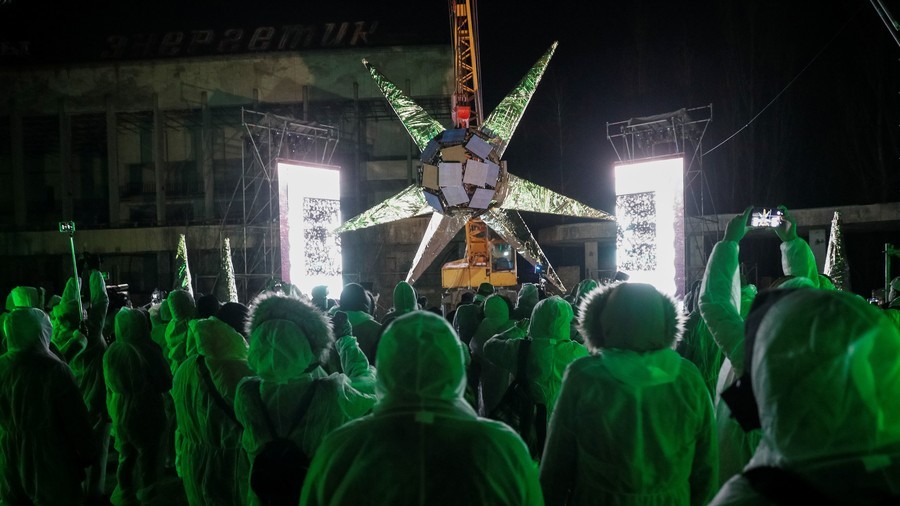Chernobyl. The name doesn’t often crop up in slick advertisements, or in the dusty windows of foregone travel agents. Instead, it’s more likely associated with images of toxic waste, flashing warning symbols and widespread sickness than your next sun-soaked holiday in the Mediterranean. Now, it’s set to be home to the first ‘cultural event’ held inside the exclusion zone for 30 years.
Quite frankly, whoever works in Chernobyl’s PR team needs a hefty raise for the mere suggestion of trying to turn the abandoned Ukranian powerplant into the next selfie-ready, instagrammable tourist hotspot. But in the last few years, tour guides and package holidays have popped up, with the tourist information centre even touting radioactive ice-cream and novelty gas masks. The next development that the tourist information centre promises is Artefact, Kiev artist Valery Korshunov’s latest project, and it delivers a heady mix of light show, rave and arthouse film all fused into one. The result? Something which appears more random than radical.
First, some background (radiation) information.
The Chernobyl disaster – in which more than 400 times the amount of radioactive fallout than that of the Hiroshima bomb was released into the atmosphere– occurred just outside the small former Soviet town of Pripyat, 26 April 1986. 31 people in the surrounding area were killed immediately by the blast, and it’s estimated that up to 30,000 may die from cancer-related illnesses in the coming years caused by the deadly invisible radiation that rode on air currents and poisoned the soil. A study by UNICEF suggested that more than 20% of adolescent children in neighbouring Belarus suffer from disabilities caused by the nuclear fallout. Artefact chooses not to address this.
The lure of visiting a post-apocalyptic world is nothing new: the fantasist idea of surviving after the end is an idea explored commonly in popular culture. Survivor, Mad Max, and the popular Fallout video game franchise all vouch for that. All these appeal to the escapist within us, as we all like to believe that we would be special enough to survive once the mushroom clouds have cleared. In this way, Chernobyl doesn’t need flashing lights and a disco to advertise its allure.
We’ve all seen the clickbait articles and blurred videos on the dark corners of the internet of those brave few willing to sneak past rusted iron gates and long-since abandoned guard posts in order to snatch a glimpse of the metallic husk. Over 30 years later, Chernobyl isn’t quite an open tourist resort, but tens of thousands of tourists still flock there every year in order to walk the same dusty houses and desolate schools the townspeople once inhabited. Budget hotels have shot up around the periphery. It’s very likely that artist Korshunov knew this. Come see a ravaged town’s abandoned hopes and dreams! All for a small fee, of course.
This may be an overreaction. Although it’ll never again be safe to live there, background radiation levels have sunk low enough that day trips are safe, and you’d absorb only as much background radiation as you would on a long-haul flight. According to Korshunov, this space now needs to be filled with new meaning after only being considered as a site of national mourning. On his website, he describes his project as an answer to “digitalization and general overload of information space, the dominance of fake news and the low level of media literacy of the population.” How flashing lights, projected film and dance music quite address this issue aren’t made clear.
Art can capture feelings in a specific time, art can impart the creator’s feelings on an audience, and art can present us with a biased viewpoint of an event. Yet, Korshunov’s content seems almost apolitical, neatly skirting around many of the still-taboo issues connected with Chernobyl and the use of nuclear energy in the present day. Nothing is said about the government’s reluctance in addressing the past, the displaced people of Pripyat, the killed. Why be so determined to hold a project about fake news inside the remains of a former Soviet powerplant (that hid the dangerous news from inhabitants for 36 hours) if this eye-wateringly apparent irony isn’t going to be addressed? There seems to be no gain from setting it against this tragic backdrop other than to appear controversial or to present some sort of gimmick. It’s impossible to separate the past from the present in what is such a loaded and evocative space.
Holding a “cultural event” which is completely devoid of any meaning of what makes a site so significant in the first place is a hollow and tasteless act. Through Korshunov’s work, Chernobyl is being pushed into nuclear winter again: cold, empty, and toxic.
George Dunleavy
Image Courtesy of Reuters / Gleb Garanich

